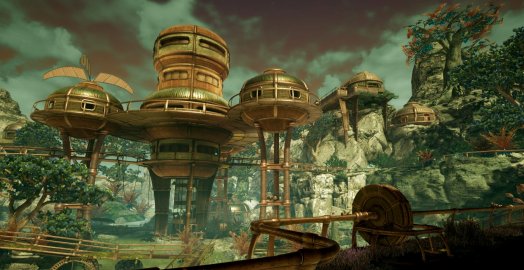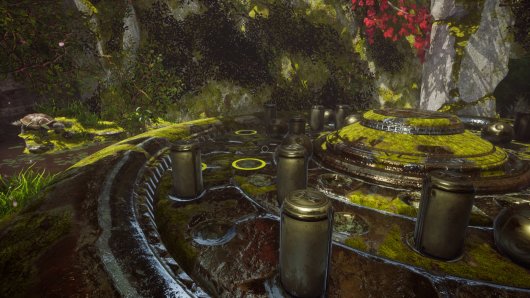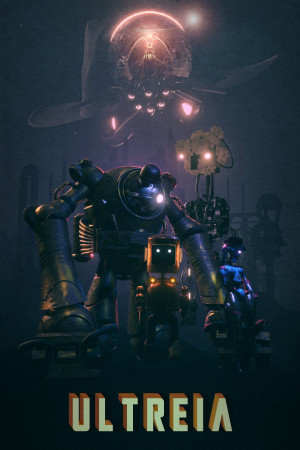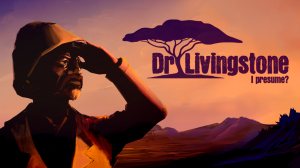Review for Nemezis: Mysterious Journey III

In 1993 Myst exploded onto the gaming scene, ushering in a new subgenre of solitary puzzle-heavy adventure games set in lushly detailed though sparsely populated worlds. Other developers took notice and before long we were overrun by so-called “Myst clones,” some of them good, many of them not. Included in that wave of popularity were a pair of Mysterious Journey games (or Schizm as the series was known in North America at the time). Now, nearly twenty years after its predecessors, Detalion Games brings us a brand new first-person real-time 3D installment called Nemezis: Mysterious Journey III, which absolutely looks like it could have been a lost Myst game. Unfortunately, as with many such games before it, this one fails to get pretty much everything else right.
Amia and Bogard are siblings who have traveled from Earth to Regilus, an alien world, via a matter teleportation system. The pair have won a contest for being in the top 1% of intellects on Earth and are on Regilus to enjoy a vacation at the Andromeda Hotel. It’s immediately apparent that things aren’t on the level, however, as Amia and Bogard materialize far apart from one another with no hotel in sight. They must overcome arbitrarily placed puzzles – the game itself has characters straight up call them puzzles and remarks on their arbitrariness with a fair degree of regularity – to reach the Andromeda to be reunited. The journey they embark on is divided into six main levels, alternating between Amia and Bogard.
Nemezis is certainly a beautiful game. It looks like what your fondest, rose-coloured memories of Myst look like. Dome-topped buildings are constructed of brass, copper, rich wood paneling and interestingly veined stone. Pathways wend their way along rocky cliffs, somber mine tunnels, platforms floating in the sky, and even a small city block with European-influenced open-air cafés. In one area you may find broad avenues with grand arches lining the streets; in another, a towering well with waterfalls cascading about. Many of these places are teeming with life, from birds of various plumage, to vibrantly hued lizards, to swimming fish with light glinting from their scales, with various plant life blowing in the breeze for good measure.
All of these locations are richly detailed, but it’s not just the visuals that impress; the lovely settings have been skillfully realized audibly as well. Unseen crickets chirp in the grasses, birds whoop and holler, the burble of surf drifts through the air when near an ocean, machinery whirs and grinds. The graphics and ambient sound effects all come together to build an alien environment with a fantastic atmosphere, especially when you throw in the occasional piece of moody Myst-inspired instrumental music that evoke an air of mystery or wonder at suitably appropriate times. It’s a world that would be a lot of fun to explore if its generally poor puzzle design didn’t keep getting in the way.
From the beginning, Nemezis positions itself to be all about solving puzzles. It’s unfortunate then that the majority of challenges are either solved by brute force or random actions, involve mindless pattern matching, have awkward interfaces, or are just plain too long to be very much fun. Take for example one level where Amia finds herself on a floating platform that engineers built because, as one character relates, they thought it would be a good idea to have a puzzle in the sky on the way to the hotel. The platform itself is made of several concentric rings, with Amia standing in the middle. Each circle has segments of its floor missing and low rails like the line separators for a ride at an amusement park. Some of these rails have openings that allow movement from one circle to the next.
The task here is to turn wheels in the center to form a path from there to one of four mechanical devices arranged around the outer perimeter. Each wheel moves two of the rings and you need to work out what order to move them in to create a passage through the maze. The problem is that the ground-level view from the center of the circles is not conducive to this type of puzzle as you can’t ever see the whole labyrinth at once, just whatever is in front of you at the time. With no useful overhead view to help devise a plan, I found it was easiest to just randomly spin the wheels until a path was formed with no thought going into my process whatsoever.
Adding insult to injury, you’ll need to re-solve this puzzle four times, once for each mechanical device on the other side. Each machine has several buttons that move the needles on two dials back and forth. If there was a clue as to what these devices were or what settings were needed, I totally missed it. Instead I cracked these by the simple expedient of brute force trying every dial combination possible until the game acknowledged, through a brief cutscene, that I had found the right one. Solving all four opens a door through which is a room where the dials are repeated. Here the needles can be directly set and all that’s required is to copy the dial settings on the four colour-coded terminals outside. The result is that this entire level, out of just six in total, can be done with no thought whatsoever, just a lot of trial and error and subsequent frustration.
A lack of strategic thinking is not the only thing that underwhelms, as the game’s interface is cumbersome too. Nemezis can be navigated with either the mouse and keyboard or a controller in typical free-roaming fashion. Either way, you are required to switch between movement mode for exploration and interact mode for manipulating devices at the press of a button. The latter prevents further movement and presents a normal mouse pointer that can be moved around to point and click on any interactive hotspots in view. (Holding the interact button down while in this mode allows the view to be rotated, but your feet are locked into place.)
This works fine on its own but many puzzles, including the rings on the sky island, require you to do a fair bit of shifting around in a small area in order to see more of the puzzle that’s being blocked by its own mechanical controls. That means you’re constantly forced to switch into and out of interact mode to both see and manipulate the pieces involved. I found this to be a bit smoother with a controller, though it never became comfortable or second nature to do.
Most of the puzzles continue in the vein of being disappointing at best and tediously annoying at worst. However, the game does save the best of its puzzling for last, as the final level actually requires gathering clues from the environment and a degree of logical thought that, for one reason or another, simply isn’t demanded elsewhere. I won’t spoil the details, but it was definitely a breath of fresh air that left me lamenting that the rest of the experience didn’t measure up.
Collectors can find an extra challenge by searching for notes and photographs scattered throughout the environments. Notes are displayed on assorted computer terminals and provide bits of backstory. However, they’re so brief and deal with matters seemingly unrelated to what’s going on in the game proper that I never wrapped my head around what they were trying to say. Photographs are represented in the environment by tiny blue-green swirling animations. Interacting with one of these twisters presents a still image from one of the various locations in the game, usually with some of the NPCs in it. Acquired images can be viewed again from the in-game menu, but they serve no narrative purpose.
There are a limited number of characters who can be spoken with to investigate what passes for story in Nemezis. Amia and Bogard are led by the Guide, Emmanuel, a disembodied voice that talks to them via communication gear. The Guide goads them on to solve puzzles in order to be reunited with one another. He also doles out various narrative bits, as do a few non-player characters who can be found in your travels. The problem here is their ramblings don’t really seem that coherent. I always had the feeling that Amia and Bogard and whomever they were speaking to were almost but not quite part of the same conversation. Frequently, one character or another would reference something that felt disconnected to what was going on, such as Bogard’s sudden commentary on mineral and gas mining in a conversation about Amia’s location and how the siblings can get back together.
At first the story seems to be about Amia and Bogard coming to Regilus for a vacation. That falls away as the Guide starts testing them with all the puzzles and begins to prattle on about the science of teleportation. Meanwhile, Bogard discovers that there were once miners on the planet who were either searching for a metal called austerus or possibly a gas called argilon that are supposed to be powerful green energy sources, which matters because … well, I’m not sure why exactly it matters. But that’s okay, because really the narrative is all about the native life on the planet. Except a biologist character says there is nothing indigenous because it was all transplanted from Earth because … well, I don’t know why there either. As this is the third game in the series, I’m prepared to give it the benefit of the doubt and assume it makes sense if you’ve played the previous two, which I haven’t. But for newcomers (or those who have forgotten much of what happened in the two decades since its predecessors) this is a really opaque tale and right through to the credits I never felt like I had a handle on what it was all about.
Based on the game’s Steam achievements, there are two possible endings, of which I only unlocked one. The single decision point provided throughout the whole experience is at the very start of the game when you are asked if you want to play in normal or hard mode. I chose normal and received one outcome, but presumably the other occurs when the hard difficulty is chosen. The nature of the ending I got, which I reached after six hours, made it readily apparent what the alternate one must be. Between that and a rather lengthy diatribe by a certain character about matters that as a player I had zero reason to care about, I was left with no motivation to try a replay just to see the second finale.
Other than the endings, the only apparent difference between normal and hard modes is the availability of hints for puzzles on the easier setting. When you step close to a puzzle element in the environment, the “H” key can be pressed to get help. I tried this a couple of times early on but soon abandoned the attempt. The hints I got were no better than the vague directions the Guide gave about the various puzzles anyway, and they were related to what needed to be accomplished in a puzzle although that was almost always readily apparent. The main issue I had, which the hints did not remedy, was the mechanical process of using the interface to manipulate the puzzles. In essence I was being told the what when I really wanted to know the how.
The game is fully voiced, but I almost wish it weren’t. The sporadic secondary characters you meet along the way, including a variety of engineers, a miner, and a couple of other people who were lured to Regilus for one reason or another, are well portrayed. Unfortunately, the voices I found unpleasant belonged to the three main characters. Amia would be great as a voicemail voice, but her flat, measured delivery belies any sort of anxiousness or even urgency about her situation. Bogard swings the other way, being far more emotive, but he just sounds completely irritated by everything he has to do, which gets especially frustrating in several places where he, with his genius IQ, could easily bypass puzzles if he could just learn to lift his feet to step over simple rocks or rails in his path that he otherwise has to shift through the use of overly complicated machinery.
Then there’s the Guide, who is constantly intruding on the thoughts of Amia and Bogard. While his title implies someone meant to be helpful, the character here is not written as such. It’s true that he provides vague hints and direction, but always with something of a mocking or condescending tone, as if he doesn’t feel that Amia or Bogard truly are worthy. While he is thus intended to be annoying to the siblings within the fictional context of the story, he crossed the line and became just full-on annoying to me as a player. This is compounded by him frequently chiming in to repeat unhelpful instructions for most of the puzzles. Here I was in agreement with Bogard in wanting the Guide to just shut up. So why listen to the voices if I found them so grating? Because there’s no way to turn them off. There are controls for the overall volume, music, ambient sounds, machinery, even the steps the protagonists make, but nothing for the voices.
The world of Nemezis: Mysterious Journey III is a wonderful one to wander around in. Its hi-res Myst-ian aesthetic is pleasing to the eye and there are a number of stop-and-stare sights to take in. Supplemented by excellent background audio, this is a richly atmospheric experience. Sadly, a game needs more than that to be successful. Cumbersome interfaces, tedious random and brute-force puzzles, annoying characters with grating voice acting, and a confusing narrative that excludes (at least) series newcomers combine to leave this title sorely lacking. The visual appeal alone may be worth playing digital tourist on the world of Regilus; for everyone else, there are far more engaging spots to take a puzzle-filled vacation.












__medium.jpg)
















